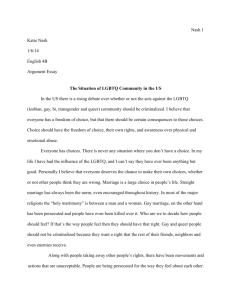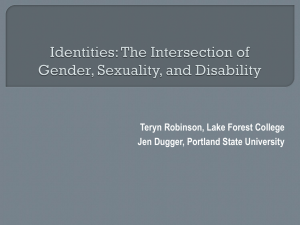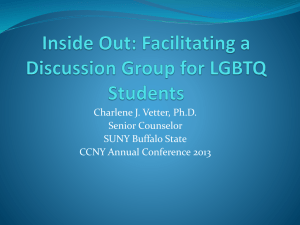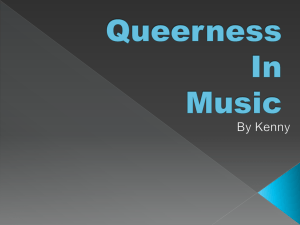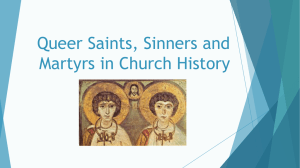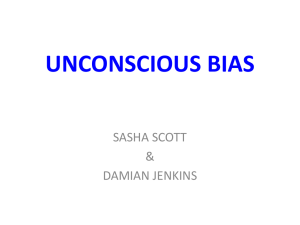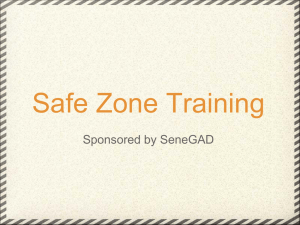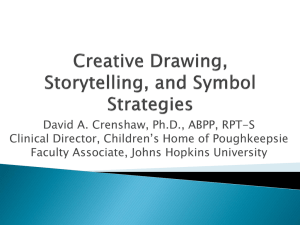LGBTQWebinar_MultipleIntersectingIdentities
advertisement
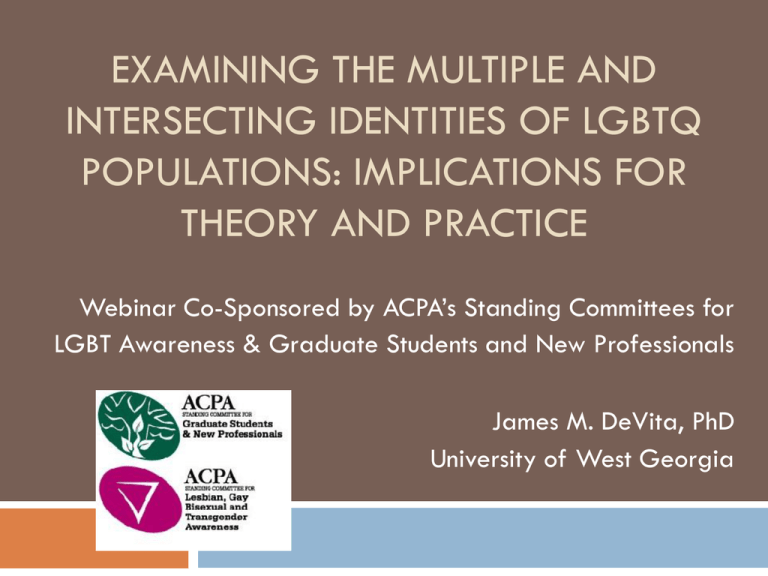
EXAMINING THE MULTIPLE AND INTERSECTING IDENTITIES OF LGBTQ POPULATIONS: IMPLICATIONS FOR THEORY AND PRACTICE Webinar Co-Sponsored by ACPA’s Standing Committees for LGBT Awareness & Graduate Students and New Professionals James M. DeVita, PhD University of West Georgia Presentation Overview Introduction & Interactive Resources Summary of LGBTQ Populations in Higher Education Theoretical Perspectives associated with LGBTQ Populations Connecting Theory to Practice Q&A Case Study Announcement Focus Purpose This webinar is designed to introduce participants to the multiple dimensions of identity associated with lesbian, gay, bisexual, transgender, and queer (LGBTQ) individuals’ development and engagement, particularly focused on the college environment. Discussion is framed around the presenter’s research on gay male college students; examples connecting research-theory-practice are derived from his work with Black gay male college students in particular. Interactive Resource Interactive Resource Utilize the following wiki page during and following the webinar to participate in on-going discussions about the multiple dimensions of identity for LGBTQ populations: http://multipleidentitieslgbtq.wiki.westga.edu/ Discussion http://multipleidentitieslgbtq.wiki.westga.edu/message /list/home LGBTQ Populations in Higher Education What do we know? Campus climate remains “chilly” for LGBTQ individuals Stereotypes matter Harassment and discrimination persist in HE “Real” consequences Growing presence, expanding initiatives Individuals disclosing identity at earlier ages Development of programs present on some campuses; resisted on others? Diversity within LGBTQ community is meaningful Theoretical Perspectives associated with LGBTQ Populations Developmental theories Freud (1905): Inversion theory Cass (1979, 1984): Stage-based, developmental theory Considering contextual influences: D’Augelli’s (1994) framework Complicating identity Multiple identities Queer theory Intersectionality D’Augelli’s LGB Identity Development Model Process Summary Exiting heterosexual identity Personal and social recognition of a homosexual orientation; includes disclosure of identity to others; continuous process affected by the openness of one’s sexual orientation Developing a personal LGB identity status Development of a socioaffectional identity that emerges from interaction with other LGB individuals; individuals also begin to challenge heterosexist assumptions Developing a LGB social identity Individuals establish a large, affirming social network of LGB individuals and heterosexual allies Becoming a LGB offspring Disclosure of LGB identity to family members and their subsequent acceptance of that identity in an affirming manner Developing a LGB intimacy status Establishing meaningful same-sex relationships that are both emotionally and intimately fulfilling Entering a LGB community Commitment to the social and political action that empowers individuals to understand oppression and resist it Significance of Studying Multiple and Intersecting Identities for LGBTQ Populations Renn (2010): “Modernist and critical approaches that rely on fixed definitions of gender and sexuality limit what can be known about the identities and experiences of LGBT students, faculty, and administrators. Furthermore, general problems and questions of access, equity, learning, and leadership— among others—persist across all sectors of postsecondary education, despite decades of research and attempted policy fixes. Queer theory might shed light on these problems through research that questions normative constructions of socially constructed binaries such as male/female, teacher/learner, leader/follower, research/practice, or K–12/postsecondary” (p. 132). Model of Multiple Dimensions of Identity Originally developed by Jones and McEwen (2000) and revised by Abes, Jones, and McEwen (2007), the model of multiple dimensions of identity positions identity within a social-constructivist frame that accounts for multiple, intersecting identities and the ways in which individuals embody multiple aspects of identity. The framework is organized around three parts: Contexutal Influences - Similar to the ways external influences included in D'Augelli's (1994) LGB identity development model, contextual influences refer to the various cultural impacts in which individuals are immersed. Peers, family members, societal norms, and stereotypes are among the contextual influences discussed in the model. Meaning-Making Filter - Abes, Jones, and McEwen state that "depending on complexity, contextual influences pass through [the meaning-making filter] at various degrees" (p. 7). This means that depending upon the degree to which an individual values contextual influences, their influence on the individual within a given context, and the opportunity for an individual to consider those influences, the filter opens and closes to allow contextual influences to pass through at varying degrees. Self-Perceptions of Multiple Identities - The third component to MMDI is how an individual chooses to identify and where he/she/ze places various identities in relation to their core. The initial model of multiple identities represents this aspect of identity as a series of elliptical orbits of social identities moving around the individual's core. Connecting Theory to Practice Theme: Conflicts with Cultural Influences Sidney: parents were missionaries in a conservative Christian sect, explained, “when I go to church its like I go back into the closet.” Yet, while on campus he is an active leader in his college's LGBT organization. Lawrence: spoke at length about his experience attending a “Black church” while the preacher was delivering an anti-gay sermon. Lawrence’s discomfort in that instance led him to seek a different church that he considered more “gay-friendly.” Making Connections to Theory Abes, Jones, and McEwen describe three types of meaning making: "formulaic, transitional, and foundational." Each type reveals the degree to which an individual's filter was opened to allow contextual influences to shape their perceptions of self and experiences. In the example above, Sidney and Lawrence both allow contextual influences to shape their experiences, but to different degrees--and in different ways in various spaces. The connection between religion and family for Sidney forces him to remain closeted in certain spaces (church, home), while being open and even politically and socially engaged in LGBT work in other spaces (on campus). In contrast, although religion played an important role in Lawrence's life he was determined that it would not force him to deny his sexual orientation. Rather than remain closeted in church, Lawrence sought other ways to engage with his religious identity that also celebrated his sexual orientation. These two examples demonstrate the ways in which different individuals with similar values and experiences can determine the degree to which contextual influences will impact their identity. https://docs.google.com/spreadsheet/viewform?hl=en_US&formkey=dFZWRlB0UzZsZGVuTS03WHJfVTU5Q1E6M Q#gid=0 Queer Theory Queer theory was developed from feminist perspectives that seek to challenge traditional constructions of gender and "normal" identities. Focused on: Challenging what we "know" about the ways in which sexual orientation is developed, performed, and interpreted by individuals with particular attention given to the intersections of gender and sexual orientation. Complicating traditional notions of sexual orientation as "normal" or "abnormal" may utilize a queer perspective, particularly if examining the ways in which gender and sexual orientation are performed is framed as a challenge to the dominant heteronormative discourse. “Queer, in the context of educational studies, pertains to issues of homosexuality, and refers more specifically to lives or practices not considered ‘normal.’ Queer theory houses the analytic tools used to examine what is ‘normal’ and ‘abnormal,’ primarily through deconstructing issues of sexuality in society. . . This queering is the result of someone, either the subject, the researcher, or the audience, determining that the lives and experiences of—the data derived from—the subjects are not what an audience, or a writer, thinks the data ‘should’ be” (Dilley, 1999, p. 469). Connecting Theory to Practice Theme: Interpreting Gender Blake: recalled a story of holding his mother’s purse while she took groceries inside. As a result of holding a purse, which was perceived by his father as a “feminized action,” he suffered verbal abuse (i.e., called a “sissy”) and mild violence from his father. Through his example, Blake reveals how his father’s words influenced his beliefs about masculinity and his gay identify, which stifled his sexual identity development. Terrance: talked about a Black gay male he saw on campus as a "Tina...like a girl pretty much. That's what [we] use for a girl. And when I see that I'm...I kinda stop and like, "Am I like that?" Because I really don't want to be." Terrance's reaction to an effeminate Black gay male is representative of what all the participants affirmed: that they were more masculine than the typical Black gay male they encountered. Despite being involved in activities like cheerleading and opera, participants were protective of their masculinity. Connections to Theory Gender clearly played a significant role in how Black gay male participants positioned themselves in relation to other Black males, other gay males, and other Black gay males. The construction and performance of gender was always linked to some other aspect of identity. For Blake's father, a heterosexual Black male, his son's act of holding a purse created dissonance between his expectations of appropriate male behaviors and the way in which his son was acting. Blake believed that although he was not "out" to his father at the time that his father's reaction was due to a connection between the performance of gender that his father labeled "abnormal," which in turn became associated with an "abnormal" sexual orientation (i.e, gay). Despite his involvement in a stereotypically "feminized" activity (baton twirling), Terrance viewed his gender identity as more masculine when compared to other Black gay males he saw on campus. Although some may view Terrance's performance of gender as a deviation from the construction of a "normal" set of behaviors associated as masculine, Terrance viewed himself, particularly in relation to others, as a masculine gay male. https://docs.google.com/spreadsheet/viewform?hl=en_US&formkey=dGxFcHJkVzVJYkRLWW5CLW1UT003VEE6 MQ#gid=0 Intersectionality Based on Crenshaw’s (1991) work in critical legal theory and critical race theory, which argued that discrimination based on a single categorical axis of identity perpetuated marginalization of individuals with multiple identities. Criticized the courts for forcing Black women to interpret discrimination based only on race or only on gender, but not both: “Because, the intersectional experience is greater than the sum of racism and sexism, any analysis that does not take intersectionality into account cannot sufficiently address the particular manner in which Black women are subordinated” (58). Separately, racism and sexism do not account for the raced and gendered experiences of Black women, which “highlights the need to account for multiple grounds of identity when considering how the social world is constructed” (94). Though Crenshaw believed intersectionality could be one way to recognize difference and still organize politically to affect change, she argued that “ignoring difference within groups contribute(d) to tension among groups” (p. 1242). Crenshaw critiqued the deployment of monolithic categories in identity politics; thus, the use of “LGBTQ” to refer to multiple individuals and no less than four different communities (i.e., lesbian, gay, bisexual, and transgender) erases the everyday lived experiences of multiple targeted identities. LGBT communities are not only white, middle-class communities (DeVita 2010; Renn 2010). Connecting Theory to Practice Theme: Where Do I Belong Several participants: members of predominantly white LGBT organizations on their respective college campus. Expressed being more comfortable around white people, said most of their friends were White, and that they were primarily attracted to White men. One participant, for example, labeled himself the “whitest black boy there is.” However, despite feeling that their gay identity impeded their interaction with other Black men on campus, participants still seemed to be acutely aware of their race when engaging with White LGBT individuals. One participant described how he would frequently resort to making “the Black joke that everyone is thinking but is not really saying” around his White gay friends to protect himself from racism and to ease any existing racial tension. Despite encountering racism in LGBT spaces on a regular basis, participants also noted that it felt safer than predominantly Black spaces where homophobia was consistently present. Making Connections to Theory Crenshaw's (1991) concept of intersectionality relates to the ways in which society supports and perpetuates systems of oppression that link and perpetuate marginalized identities for Black women. Consider the following parallel between Crenshaw's concept and the experiences of Black gay males: Crenshaw states that "Because women of color experience racism in ways not always the same as those experienced by men of color and sexism in ways not always parallel to experiences of white women, antiracism and feminism are limited, even on their own terms" (p. 1252). Similarly, Black gay males experience racism differently from Black straight males and issues associated with gender and sexual orientation differently from white gay males. Thus, efforts to address racism and homophobia are limited when identifying the needs of Black gay males. https://docs.google.com/spreadsheet/viewform?hl=en_US&formkey=dE90SnhIM1IxUW16RjViTWwzWXVwVHc6M Q#gid=0 Implications for Practice Model of Multiple Dimensions of Identity http://multipleidentitieslgbtq.wiki.westga.edu/MMDI+I mplications Queer Theory http://multipleidentitieslgbtq.wiki.westga.edu/QT+Impl ications Intersectionality http://multipleidentitieslgbtq.wiki.westga.edu/Intersecti onality+Implications Winter Case Study Competition The winter case study will be an opportunity to demonstrate your ability to connect the above theory to practice webinar information in a defined situation. Participation is free. Teams can consist of up to five members and may include both graduate students and new professionals. To register, email bthopkin@syr.edu before 11:59 pm EST on November 18, 2011. Thank You Questions, comments, suggestions, etc. can be directed to: James DeVita at jdevita@westga.edu Feel free to continue to utilize resources on the wikispaces page, including the discussion board. http://multipleidentitieslgbtq.wiki.westga.edu/ http://multipleidentitieslgbtq.wiki.westga.edu/message /list/home
